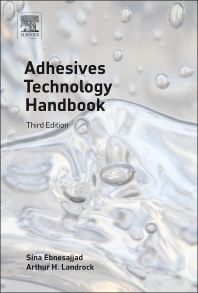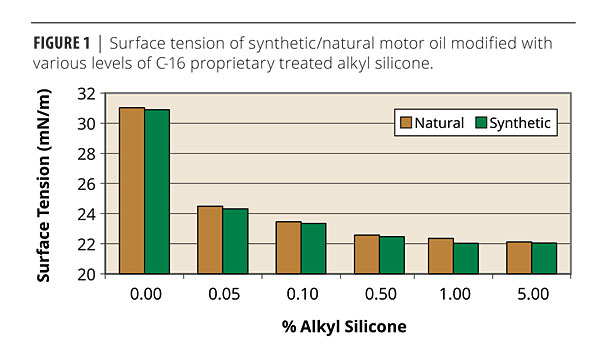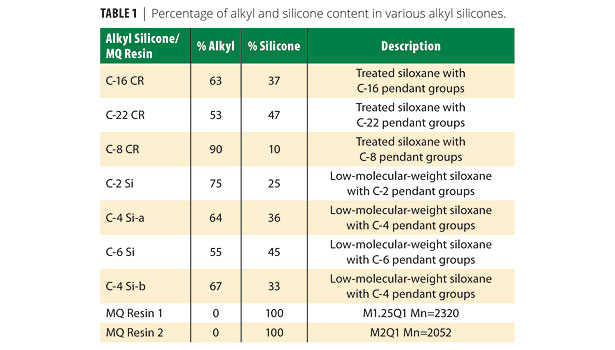Silicone Additives Increase Solids and Lower VOCs in Solventborne Systems






































This paper was presented at the 39th Annual Waterborne Symposium, February 2012, in New Orleans.
To comply with VOC regulations, coatings manufacturers have gradually moved away from conventional low-solids, solventborne systems to several emerging technologies, which include high-solids, UV, powder, waterborne and solvent-free systems.1-3
The major barrier in achieving high-solids is the rheological requirement of the coating. Applying a thin coat uniformly to a complex surface requires the coating to have good flow and suitable viscosity at a wide range of shear rates.4-6 Coating viscosity depends very much on the molecular weight and molecular weight distribution of the resin used. One of the key approaches to increasing coating solids has been focused on the redesign of resin structure, i.e., lower molecular weight, narrower molecular weight distribution and higher functionality, to achieve desirable rheological characteristics and film properties.7,8
Using lower-molecular-weight, higher-functionality and more linear resins can produce lower viscosity but can create application problems. For example, a coating prepared with a low-molecular-weight resin could have high sag, low film toughness and high sensitivity to less than perfectly cleaned substrates. Another approach to achieve high-solids is to use additives in the formulation.9 It is well known that a small amount of additives, such as silicone materials, can be used to minimize foam during application, to improve sag, flow and wetting, and to enhance slip, mar and stain resistance of the dried film.
Alkyl silicones have been widely used in personal care products to improve playtime (the length of time the rub-out takes for the cushion to disappear) and smooth feel.10 Alkyl silicones have better solubility in oils and esters than pure silicone fluid. The solubility of alkyl silicones in oils and esters depends strongly on chain length and type of alkyl group on the molecule, as well as the degree of proprietary molecular weight modification of the silicone backbone. These modified alkyl silicones provide many unique properties, such as softness, lubricity, gloss and emoliency in skin care applications. Some low-molecular-weight alkyl silicones provide excellent dry feel in personal care formulations and have been used as a suitable replacement for cyclopentasiloxane (D5), the use of which may become limited in some applications due to recent regulatory developments. Based on its compatible nature with organic compounds, alkyl silicones have also been incorporated in coating formulations to improve solids, applicability and film properties.
Some silicones, such as defoamers with a high percentage of silicone content, are not compatible in waterborne and solventborne systems. These insoluble silicones will sometimes cause fisheyes and craters in the film. Using an alkyl silicone or silicone surfactant with silicone defoamer or surfactant in the coating formulation could resolve some of these issues. Alkyl silicones are not only compatible with most waterborne and solventborne coatings, but also provide better oxidation stability and less temperature-dependent rheology. Using the alkyl silicone with the right amount and type of alkyl group together with silicone defoamer can significantly eliminate fisheyes and craters as well as enhance the effect of the silicone defoamer.
It has recently been discovered that alkyl silicones can be used as effective surface modifiers for a number of oils and esters. The surface tension of these oils and esters can be significantly lowered, which is particularly important for many applications. In this study, we investigated the effect of using these alkyl silicones in several solventborne systems. The rheology and the film properties of these solventborne paints were also evaluated. The primary goal of this project was to demonstrate the effect of alkyl silicone on rheological and film properties of high-solid coatings. It was expected that lowering the surface tension and viscosity of the coating with these alkyl silicones would allow for higher-solids and lower VOCs in the coating. The type and the chain length of alkyl as well as the degree of proprietary treatment were investigated to see how they affected coating performance.
MQ resins, which in simple terms are silicone resins highly crosslinked with a series of silicone connected with four oxygen groups (Q) and endcapped with a mono (M) silicone with one oxygen group, have also been found to be effective surface modifiers, and are used successfully in defoaming and personal care applications. It is thought that MQ resins can also be useful in paint to reduce viscosity. The benefit of having lower viscosity is to provide the formulator with greater feasibility in preparing higher-solids coating. This study also explored the effect of MQ resins on the rheological and film properties of high-solids coatings. Some MQ resins were screened against alkyl silicones as well.
Experimental
All test panels were prepared by drawing down approximately 1 to 3 mL of paint on 4” x 6.5” Leneta paper or 4” x 6” aluminum panel with a wire-wound rod, depending on the viscosity and the wet film thickness of the coating. The wet film was air-dried for 2 days for oil-based paints or in a 110 °C oven for 2 h for acrylic melamine paints. Gloss was measured with a BYK-Gardner 60° micro-gloss meter. Viscosity was measured using a Brookfield Rheometer DV-III with an appropriate spindle at various shear rates. A ChemInstruments Coefficient of Friction 500 was used to measure friction coefficient with the setting: 15 cm/min test speed and 200 g sled weight. A Sutherland 2000 Ink Rub Tester was used to measure mar resistance with the settings: 50 - 500 rubs with a nylon scrubbing pad and 84 rpm stroke speed. The mar resistance was determined by the percentage change in gloss reading before and after rubbing. Flow was measured by running distance of 0.2 g of paint on Leneta paper at a 45° angle for 5 min. Table 1 shows the alkyl silicones and MQ resins that were used in the experiment.
Alkyl Silicone as a Surface Modifier for Oils
Alkyl silicones were found to be effective surface modifiers for oils. Figure 1 demonstrates that the surface tension of motor oil was significantly reduced with an addition of a small amount of modified alkyl silicones. A proprietary treated alkyl silicone with hexadecane pendant group (C-16 CR) was able to induce the silicone backbone acting on the surface of the oil effectively. The alkyl pendant group in the molecule, which is the oleophilic portion of the alkyl silicone, was expected to dissolve well in the oil, whereas the siloxane portion has a tendency to migrate to the surface, lowering the surface tension. With only 0.5% alkyl silicone added to the oil, the surface tension decreased from 31 mN/m to 22 mN/m. The surface tension reduced to 24 mN/m even at a 0.05% level. It is also interesting to observe that many stable bubbles were formed in the oil when the oil blended with 0.05% C-16 CR was shaken by hand gently a few times. The corresponding untreated alkyl silicone was found to be less effective. This indicates that the proprietary treatment played a key role in reducing surface tension of the oil.
A low-molecular-weight alkyl silicone with ethyl pendant groups (C-2 Si) was also found to be an effective surface modifier for vegetable oils. Figure 2 indicates that the surface tension of various vegetable oils was reduced significantly with an addition of 2% alkyl silicone. C-2 siloxane in oils has been used as a replacement for D5, which is widely used in personal care products.11 Although they are not as effective as the treated alkyl silicone in reducing surface tension of oil, the fundamental principle of reducing surface tension is the same for both types of alkyl silicones. The organic portion of low-molecular-weight alkyl silicone is compatible with the oil and pushes the silicone portion to the oil surface. It is ascribed to the fact that the low-molecular-weight alkyl silicone was very mobile and made the oil flow better and gave lower viscosity and lower surface tension than the control without alkyl silicone. In summary, both treated and low-molecular-weight alkyl silicones were found to be very effective surface modifiers to reduce surface tension of oils.
High-Solids Gloss Black Enamel
A high-solids black enamel (315 g/L VOCs and 60% solids) was used in the study. These high-solids enamels usually contain organic resins made from long-chain alkyls, which are derived from vegetable oil. In some cases, a high percentage of oil-derived resin is used in the paint formulation. Due to the oil content in the paint, alkyl silicone could play an important role in modifying the paint rheology and its film properties. As discussed previously, the alkyl group on alkyl silicone is expected to be soluble in the oil-containing compound, forcing silicone groups to arrange on the surface. Because of this, the siloxane portion of the alkyl silicone becomes very active on the surface, thus lowering surface tension and viscosity, as well as enhancing flow.
Figures 3 and 6 indicate the results of viscosity and flow at various shear rates for the gloss black high-solids enamel treated with 0.5% alkyl silicone additive. Among all the test samples, C-2 Si generated the lowest viscosity. All of the samples prepared with alkyl silicone had better flow than the control. There was no significant difference in viscosity among the low-molecular-weight alkyl silicones, but their viscosities were all lower than the modified alkyl silicones. This may indicate that low-molecular-weight alkyl silicone was more flowable than the modified longer chain in the paint medium. There was no clear pattern observed with respect to alkyl chain length vs. viscosity. Some other factors in molecular structure or interaction may have played some role in the viscosity measurement.
The film properties of enamel prepared with alkyl silicones were found to be significantly improved. Figure 4 indicates that the coating prepared with treated alkyl silicone had lower surface tension, lower coefficient of friction and better mar resistance than the control and other alkyl silicone. As discussed previously, the modified silicone portion of the alkyl silicone can migrate to the coating surface more effectively during drying, resulting in lower friction and better mar resistance. On the other hand, the finish prepared with low-molecular-weight alkyl silicone contained fewer fisheyes than the control, whereas modified alkyl silicone had similar or slightly more fisheyes than the control. These defects are considered to be trivial and will not affect the aesthetic appearance of the coating, particularly when using spray application equipment.
MQ resins have also been used successfully in defoaming and personal care due to their effectiveness as surface modifiers to reduce surface tension and viscosity of the medium used. As indicated in Figures 3-5, MQ resins also gave very low viscosity as compared to the control and other alkyl silicones. The MQ resin molecules are thought to arrange themselves in cubes with layered and planar structures and cover effectively on surfaces with a very thin layer of molecules.
The finish with MQ resin was slightly tacky due to the low-molecular-weight MQ resin used in the study, resulting in high friction and poor mar resistance. Figures 3-5 indicate that the lowest viscosity was obtained from the sample prepared with MQ resin, but it gave the highest surface friction and the lowest rating in mar resistance due to the presence of surface tack. It was expected that using higher-molecular-weight MQ resin could resolve the tack issue and improve the slip and mar resistance.
A higher-solids black enamel (259 g/L VOC and 65% solids) was also prepared by adding more viscous resin in the formulation for this study. As indicated in Figure 5, all of the paint samples prepared with alkyl silicone gave significantly lower viscosity than the control. The viscosity of the control increased rapidly with an addition of thick resin, whereas the viscosity and flow of alkyl silicone samples increased just slightly under these conditions (Figures 5 and 6). The surface tension results for the higher-solids black enamel paint are shown in Figure 7. CR alkyl silicones and MQ resins showed the lowest surface tension, which had the same trend as in the lower-solids enamel. All the samples treated with alkyl silicones had lower friction and higher mar resistance than the control. The effect of alkyl silicones on improving the film properties for the higher-solids paint was higher than the corresponding lower-solids paint (Figure 7).
In summary, the use of some alkyl silicones can lower viscosity, improve flow and allow for higher solids. The low-molecular-weight alkyl silicone gave lower viscosity than the modified alkyl silicone in the enamel paint, whereas the latter gave better slip and mar resistance of the dried film than the former. The effect of alkyl silicone on reducing viscosity became prominent. The benefit of using alkyl silicone to prepare paints with increasing solids became obvious.
High-Solids Gloss White and Clear Topcoat with Unsaturated Nutshell Resin
In response to stricter VOC regulations and demand for higher coating performance, resins derived from cashew nutshell liquid have been developed for many coatings applications.12 A high-solid white topcoat with nutshell resin (153 g/L VOC and 89% solids) was prepared using the formulation in Table 2.
The viscosity differences among all the test samples were insignificant, as demonstrated in Figure 10. C-22 CR gave the lowest viscosity at low shear rate, whereas C-2 Si gave the lowest viscosity at high shear rate. Figure 8 indicates that most of the samples containing treated alkyl silicone gave lower surface tension than the control. Treated alkyl silicone seems to be more compatible with the nutshell resin than low-molecular-weight alkyl silicone. The low-molecular-weight alkyl silicones had no observable effect on viscosity. In fact, C-2 Si and C-4 Si had higher viscosity than the control. They were not totally compatible with the nutshell resin. The film properties for the high-solids white nutshell paint listed in Figure 9 indicate that alkyl silicones gave significant improvement in slip and some improvement in mar resistance.
A higher-solids white topcoat with nutshell resin (86.8 g/L VOC and 94% solids) was also prepared using the same ingredients but with more resin and less solvent. The surface tension of the higher-solids nutshell paint showed the same pattern as in the lower-solids series. Treated alkyl silicone gave lower surface tension than the control and low-molecular-weight alkyl silicones (Figure 8). There was no significant difference in viscosity at low shear rate. But low-molecular-weight alkyl silicones gave lower viscosity at higher shear rate than the control and treated alkyl silicones (Figure 10).
Overall, the effect of alkyl silicone on viscosity for nutshell paint was minimal. Nevertheless, the overall film properties of the higher-solids white nutshell paint were improved significantly for the samples treated with alkyl silicone (Figure 11). The samples prepared with alkyl silicone were found to have better slip and mar resistance than the control. The extent of the improvement was similar to those for the lower-solids series. Similar results were also obtained for a higher-solids clear nutshell topcoat having 99.4 g/L VOC and 90% solids (Figure 12).
MQ Resin1 gave the lowest viscosity at low shear rates among all the test samples. The surface tensions of the samples prepared with MQ resin were lower than the control and all modified alkyl silicones, but higher than the low-molecular-weight alkyl silicones. The high-solids finish with MQ resin was slightly tacky due to the low-molecular-weight MQ resin used in the study, resulting in high friction and poor mar resistance. The surface tackiness nutshell resin was reduced significantly with a higher-solids nutshell paint. The surface fraction for the samples prepared with MQ resin was not as good as those prepared with alkyl silicones.
In summary, although no significant change in viscosity between the control and the alkyl silicone samples was observed, the coating prepared with modified alkyl silicones showed excellent slip and low surface tension while low-molecular-weight alkyl silicones gave good slip and good compatibility with this very high-solids formulation. The high-solids and higher-solids coatings were very similar in performance.
High-Solids Acrylic Melamine White Coat
Melamine formaldehyde resins have widely been used to crosslink many hydroxyl-functional resins for high-solids coating applications.13 A high-solids white topcoat with acrylic melamine resin having 224 g/L VOCs and 83% solids was prepared for electrostatic spray using the formulation in Table 3.
The acrylic melamine coating was cast on an aluminum panel and cured at 110 °C for 2 h. The viscosity of this formulation was relatively low, which is suitable for electrostatic spray application. The effect of alkyl silicone on viscosity and flow for this system was trivial (Figures 14 and15). As indicated in Figure 13, the samples prepared with alkyl silicone showed slight reduction in slip and surface tension but had insignificant effect on viscosity, flow, wetting and mar resistance. Alkyl silicone was less compatible with an acrylic melamine system than with oil-based paint. The sample prepared with C-22 had low gloss. Also, most of the samples prepared with treated alkyl silicone contained some fisheyes.
A higher-solids acrylic melamine topcoat having 93 g/L VOCs and 92% solids was also prepared using the same ingredients with more resin, filler and less solvent. The alkyl silicones had greater effect on this much higher-viscosity paint than the lower-solids one (Figure 15). All of the samples prepared with alkyl silicone showed lower viscosity than the control. The surface tension for the sample prepared with alkyl silicone was also found to be lower (Figure 16). The differences in viscosity and surface tension between the alkyl silicone and the control are considered noteworthy. The film properties of higher-solids acrylic melamine paint were similar to those of the lower-solids series. This reduction of viscosity and surface tension will be beneficial in formulating high-solids coatings.
MQ resins gave the best flow and the lowest surface tension among all the samples in the high-solids acrylic melamine topcoat series. The surface tension and the viscosity of the higher-solid paint were also found to be significantly lower than the control. However, the film properties i.e., slip and mar resistance, were poor due to the surface tack for both the high and higher-solids series.
In summary, alkyl silicone showed some benefit for very high-solids acrylic melamine paint, but it had less effect on viscosity, surface tension and film properties than for oil-based paint.
Summary
Alkyl silicones were found to be very effective at reducing surface tension, improving flow and reducing defects in very high-solids solventborne systems. Both modified and low-molecular-weight alkyl silicones were found to be very effective surface modifiers to reduce surface tension of oils, which will allow formulators to increase solids without adversely affecting performance. This study has demonstrated the positive effect of alkyl silicone on the rheological properties and film performance for three different coating systems.
The relationships between the film properties and the chemical structures, i.e., the type and the chain length of alkyl as well as the degree of treatment, were also investigated. For high-solids black enamel, low-molecular-weight alkyl silicone gave lower viscosity than the treated alkyl silicone, whereas the latter gave better slip and mar resistance of dried film than the former. The effect of alkyl silicone on reducing viscosity became prominent for very high-solids paints.
In the case of the nutshell paint formulation, although no significant change in viscosity between the control and the alkyl silicone samples was observed, the coating prepared with modified alkyl silicones showed excellent slip and low surface tension while low-molecular-weight alkyl silicones gave good slip and good compatibility with these very high-solids nutshell formulations.
Alkyl silicone showed some benefit for very high-solids acrylic melamine paint, but it had less effect on viscosity, surface tension and film properties than for oil-based paint. The benefit of using alkyl silicone became obvious in very high-solids paints. This will provide formulators with greater feasibility in preparing even higher-solids coatings successfully.
MQ resins gave low surface tension, low viscosity and good flow in many of these coating systems. In some cases, the surface tension and viscosity for the samples prepared with MQ resin were even lower than those with alkyl silicones. However, the major issue of using MQ resin in these systems is the surface tack, which causes poor performance in slip and mar resistance. Using higher-molecular-weight MQ resin could resolve this problem.
References
1 Seneker, J.A. High Solids Polyurethane Coatings, U.S. Patent 4,267,081, May 12, 1981.
2 Bajc, G.L. Low-VOC Coatings, U.S. Patent 6,083,312, July 4, 2000.
3 Hoy, K.L. Waterborne High Solids Coating Compositions, U.S. Patent 5,039,759.
4 J.M. High Solids Coatings: Experience in Europe and USA, PCE 97 Conference, Paper 40, 1997.
5 Assessment of the Implementation of VOC, ENTEC, European Commission, April 2009.
6 Marshall, M.; Fields, J.L. Case Studies: Low-VOC/HAP Wood Furniture Coatings, U.S. Environmental Protection Agency, EPA/600/SR-00/043, August 2000.
7 Blank, W. J. The Slow and Winding Road to “Zero” VOC, Presented at International Waterborne, High-Solids and Powder Coatings Symposium, February 2001.
8 Belote, N.; Blount, W. Optimizing Resins for Low VOC, Presented at the Waterborne and High Solids Coating Symposium, February, 1981.
9 Blank, W.J. High Solids Coatings, ACS Meeting in Anaheim, March 1999.
10 O’Lenick, K.;O’Lenick, T. Personal Care, Page 27, September 2008.
11 Chemical Substances on Cyclopentasiloxane, Decamethyl- (D5) Page from Government of Canada, http://www.chemicalsubstanceschimiques.gc.ca/challenge-defi/summary-sommaire/batch-lot-2/541-02-6-eng.php (accessed December 12, 2011).
12 Low Color Unsaturated Resin Derived From Cashew Nutshell Liquid for Low-VOC Coating Systems, Palmer International Technical Bulletin, October 2006.
13 Blank, W.J.; Hessel, Z.A.; Abramshe, R.A. Melamine Formaldehyde Networks with Improved Chemical Resistance, Polymeric Materials Science and Engineering, Vol. 77 Page 391, 1997.
Looking for a reprint of this article?
From high-res PDFs to custom plaques, order your copy today!




























